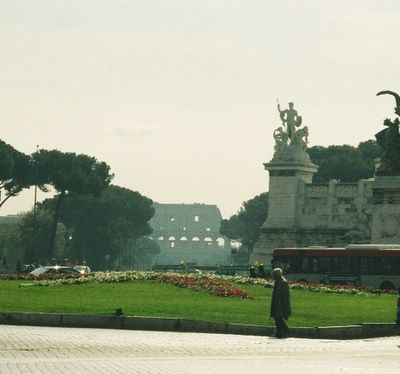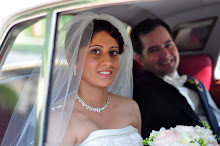ROME 2003 - Impressions
I arrived on Friday and spent some time soaking in the atmosphere. The next morning, I climbed to the top of the Vittorino at the bottom of the Via del Corso, after which I walked all the way to the top of the Corso, to the Pza del Popolo where we all met up at 2pm.
It was a packed itinerary and we did miles and miles of walking all over Rome, even though the buses were quite good. The only time we attempted public transportation was the metro to the Vatican, but when we couldn't buy tickets from the annoying machine, we all ended up in taxis anyway.
At this time of year, the days could be quite warm but the evenings cooled quickly. It was very pleasant. The colours in Italy are like nowhere else on earth, except, I hear, California.
Some places we visited are not represented in my photographs.
The Gardens and Villa Borghese.
The Villa Farnese with Raphael loggia.
Many churches and basilicas. I took pictures in the interiors of many of them, but felt bad about using my flash, so all I got were colourful blurs.
The Piazza Navona and Christie's auction rooms at Palazzo Massimo Lancellotti.
The Domus Aurea (Nero's Golden Palace) simply because it is underground, and there is nothing outside to see.
Each night, dinner increased by an hour, so that the last night's dinner lasted 4 hours and ended at midnight; we skipped dessert and jumped into taxis, our eyes rolling with exhaustion. It was almost like a Roman conspiracy to slow us down! But all wonderful.
The first night's dinner was funded by Christie's at the Enoteca Brillo Parlante. We'd started with wine at a Beergarten next door, and then wandered over to the Enoteca. They pulled out all the stops - there was wine, all sorts of antipasto, meat & cheese plate, bread with olive oil and balsamic vinegar, and the winning combination of pear and parmesan. Once we were full up, we got to order our very own pizzas.
We saw a couple of churches with ancient legacies underneath. The Basilica di San Clementi was dedicated to Mythodeas and Cyrillos, missionaries to the Slavic people who invented the Cyrillic alphabet that today forms Russian and its satellite languages. The Mithraeum in the bowels of the church was cold and spooky. We saw classrooms where the novices would learn secret rites, and an altar to Mithras himself...someone had thrown a rose into the room through the barred door...
I had a surprise experience in the Sancta Sanctorum at San Giovanni in Laterano. It is the private papal chapel in the church complex, but when we went in I forgot where we were. Thus it is without bias that I can say it really did feel holy and completely different to any other church we had entered. The ground in front of the altar was worn into a valley by the knees of hundreds of popes.
The altar image was supposedly one of the earliest portrayals of the face of Christ. Repaired, repainted, or recreated over the centuries, its latest version was a Byzantine-looking face on a silk screen. The first one, covered over many times, is said to be a wax engraving by St Luke. The docent told us that the eyes follow you.
The door of the chapel was of heavy riveted bronze, cut down from a much larger city gate-type door, one of the many that the Emperor Constantine had commissioned for the city of Rome. In the 4th century AD...
I felt slightly guilty that we had a special consular letter allowing us into the chapel, while all the pilgrims who had climbed the stairs on their knees in faith could only gaze in longingly from the other side of the iron grid windows.
Christie's had booked dinner on the last night as well but we paid our own way. Il Spirito Divino (there is surely a dual meaning there as you will see) is one of the smallest restaurants in Rome, in Trastevere (other side of the Tiber river). There were 18 of us to gather for dinner, so it was 8pm by the time we were all seated together. Between each course the table was cleared, reset, and then the orders taken. We ordered Antipasti, Primi piatti, Secondi piatti...and ran out of gas at I Dolci. However, the more adventurous of us allowed the proprietor to take us into the cellars, the remains of the oldest synagogue in Europe. Here, the Roman copy of the Apoxyomenos was excavated, which we would see the next day at the Vatican museums. By then it was midnight and we could keep our eyes open no longer, so the proprietor called taxis for us.
All in all, Rome is a magical place. It is the modern city which is forced to give way to the relentlessness of its ancient legacy.




























